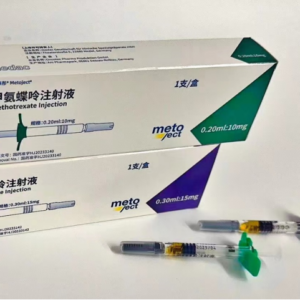Methotrexate Injection.
Effects and efficacy:
Anti-tumor acute leukemia of various types, especially acute lymphocytic leukemia, malignant lymphoma, non-Hodgkin’s lymphoma, mycosis fungoides, and multiple myelopathy. Head and neck cancer, lung cancer, various soft tissue sarcomas, breast cancer, ovarian cancer, cervical cancer, malignant hydatidiform mole, choriocarcinoma, testicular cancer, etc. Regulating immune function is suitable for psoriasis, rheumatoid arthritis, systemic lupus erythematosus, dermatomyositis, etc.
Usage and dosage:
This product is a prescription drug, and it has different uses for different diseases and different age groups. Please strictly follow the doctor’s prescription and do not use it at will. The general usage for breast cancer, choriocarcinoma, mycosis fungoides, other solid tumors, and psoriasis is 5-10 mg (2-4 tablets) orally for adults once a day, 1-2 times a week, and the safe amount for a course of treatment is 50-100 mg (20-40 tablets). Acute lymphocytic leukemia is used for maintenance treatment of acute lymphocytic leukemia, 15-20mg/m2 (6-8 tablets/m2) orally once a week. The general starting dose for rheumatoid arthritis is 10-15mg orally once a week, and the dose is increased by 5mg/week every 2-4 weeks, with a maximum dose of 20-30mg/week. The starting dose can also be 7.5mg orally once a week, or 2.5mg orally once every 12 hours, 3 times a week, and the dose is gradually adjusted to the lowest effective dose. The alternative is 7mg orally once, once every other week. Systemic lupus erythematosus is 7.5-15mg orally once a week.
Adverse reactions:
This product is well tolerated, with mild and short-lived adverse reactions. It can be determined whether treatment needs to be terminated according to the doctor’s guidance. The main adverse reactions of this product include: Gastrointestinal reactions: including stomatitis, lip ulcers, pharyngitis, nausea, vomiting, abdominal pain, diarrhea, and gastrointestinal bleeding. In addition, loss of appetite is also common, and pseudomembranous or hemorrhagic enteritis is occasionally seen. Liver function damage: including jaundice, increased alanine aminotransferase, alkaline phosphatase, γ-glutamyl transpeptidase, etc.; long-term oral administration can lead to liver cell necrosis, fatty liver, fibrosis and even cirrhosis. Bone marrow suppression: mainly leukopenia and thrombocytopenia. Long-term oral administration of small doses can lead to obvious bone marrow suppression, anemia, thrombocytopenia, and skin or visceral bleeding. When this product is used in large doses, it can cause hyperuricemia and nephropathy due to the deposition of this product and its metabolites in the renal tubules. At this time, hematuria, proteinuria, oliguria, azotemia, or even uremia may occur. Long-term use of the drug can cause cough, shortness of breath, pneumonia or pulmonary fibrosis. Hair loss, skin redness, itching or rash. Infection may also occur when the white blood cell count is low.
Drug contraindications:
Forbidden during pregnancy Forbidden during lactation For allergic to this product Forbidden for liver and kidney dysfunction Use with caution Use with caution for drinking Use with caution for children Use with caution during pregnancy preparation
Share:
Products
Our offers
Health Classification
Let us work together to protect precious health






























